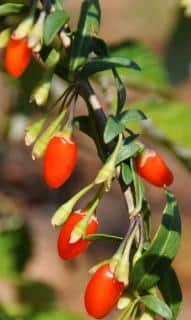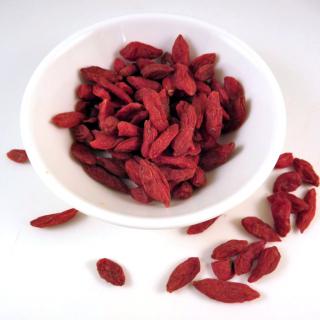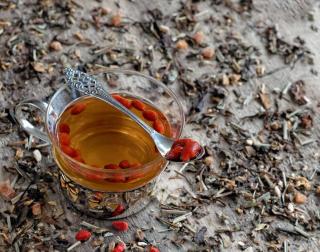

The goji berry shrub is trending ever since its health benefits and antioxidant properties have been acknowledged.
General Goji berry facts
Name – Lycium barbarum
Family – Solanaceae
Type – fruit shrub
Height – 3 to 10 feet (1 to 3 m)
Exposure – sun
Soil – well drained, rather rich, alkaline pH (6.8 to 8.1)
Foliage – evergreen – Flowering – summer – Harvest – August to October
Tips on growing and caring for goji berries, especially to trigger fruit-bearing.

Of course, since it needs a lot of sunlight, goji berry production won’t be the same if you’re farther North or farther South.
Lycium thus requires full sun exposure to produce its goji berries.
During the first years after the plant, Lycium needs to be watered often but not excessively, because it dislikes moisture.
This is the most common and easiest technique to propagate lycium for its goji berries.
Preparing cuttings means to:
Take note that Lycium is very vulnerable when young. In temperate latitudes, only transplant to the ground after at least 2 or 3 years.
Growing lycium in a pot or container for its goji berries is perfectly possible. Goji bush is even very well suited to growing indoors in an apartment.
Choose a substrate that is adequate for growing the lycium tree, like Mediterranean plant or citrus plant soil mix.
The pot must have a hole at the bottom and a drainage layer bed of gravel or clay beads to let water drain away.
The root system is similar to that of taproot plants; better to have a pot that is deep instead of shallow.

Goji berries only form for harvest earliest 2 years after planting, and don’t really become abundant until after the 4th or even 5th year.
The shrub starts blooming early on in life, but the flowers won’t set to fruit during the first two or three years. Sometimes, 5 to 7 years may be necessary.
In some climates and exposures, your goji berry tree might not be able to adjust. This happens whenever:
If after much efforts and maximum 6-7 years of patient waiting, not a single berry has formed, then there’s no hope. Try to ask around your area if a neighbor might have more success with his or her own variety. He or she will certainly be happy to share a cutting!
The goji tree is a tree that is best off pruned, otherwise it would simply grow one long stem. Pruning will make the branches grow more dense.
If the goji grows as one long stem, it will bear less fruit, which will mean less goji berries to harvest.
Consequently, the more you prune your goji, the more fruits it will bear.
There are 2 pruning seasons for the goji tree, winter and summer.
Try to make sure no leaves hover lower than 1 foot (30 cm) from the ground. This will reduce the risk of powdery mildew. Indeed, powdery mildew tends to hop on a plant when rain splashes it from the ground upwards.
Aphids are a common occurrence on lycium.
Recently, powdery mildew has been spreading across the world on infected seedlings. In 2017, it reached Australia.
Lastly, among the possible leaf-eaters, you might find hawk moth caterpillars.

In the Himalayan mountain range, common knowledge is that it helps cope with mountain sickness. Indeed, it has powerful exhaustion-alleviating and immune-defense stimulating activity.
Notably, health benefits against ageing and antioxidant properties also appear in litterature.
Goji berries seem to reinforce the immune system in an exceptional manner.
Taoists ingest it dried, and prepared goji berry juice to drink.
Goji, or goji berry, is more of a marketing name: common lycium or Chinese wolfberry are its real names.
Goji berries host many vitamins: C and E as well as vitamins B1, B2, B6, beta-carotene, proteins and flavonoids.
For instance, goji berries contain more beta-carotene than carrot and more protein than wheat.
Ingestion is typically in the form of capsules or dried berries, but if ever you can get a hold of fresh goji berries, 1 or 2 spoonfuls a day should go a long way in keeping you in top shape.
Lycium barbarum, which produces the goji berries, is quite hardy because it can grow in climates with temperatures that drop down to -4°F (-20° C).
My Goji bush two and half years old, grew too 8 feet last year, I pruned it to 5feet and planted the off cuts, it is fuller and bushier this year but I do not know what to expect, I am in Scotland.
That it grew to 8 ft is a good sign. It means the soil, light, and water is perfect for it! Normally this year you should already notice fruits forming after the blooming. You’ll have to wait for fall to pick the fruits. It loves rich soil, so go ahead and sprinkle compost on top of the ground around it, or prepare weedy tea from things you pull out from throughout the garden.
Hi gojiberry gave flowers this time but they didn’t turn into fruits.
Mine too?
Hi Klee, Khalida, I’m thankful for Klee to have bumped the question up by adding a new comment; I saw I hadn’t yet answered Khalida’s comment! Sorry for the delay, I humbly ask your apology… better late than never!
I brought together all the experience I and others have in goji berries (I’ve had a few, one of which took 4 years to bear a single fruit, a few other which have been more fruitful) and added a section to the article, titled: Goji flowering but not producing berries. I do hope it will help you solve this disappointing goji berry situation!